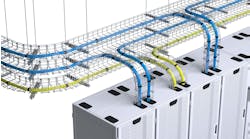The Power Play: How Data Centers and Utilities Are Reinventing Energy Strategies
The rapid growth of data centers is placing unprecedented demands on power infrastructure, requiring a collaborative approach between utilities and data center operators to address the pressing need for more power. This challenge cannot be solved by utilities or data centers as power consumers individually; it requires the involvement of all stakeholders and pockets of collaboration across these mutually intertwined industries.
Where Will the Power Come From?
As we look to find solutions to this challenge, the concept of "Bring Your Own Power" (BYOP), a transformative approach in the data center industry that emphasizes energy independence and flexibility, continues to make traction amongst data center operators. BYOP allows operators to take a more active role in sourcing, generating, and managing their own power, often through renewable energy integration, microgrids, or direct partnerships with energy providers. This model is gaining traction as data centers increasingly seek ways to ensure reliable, sustainable energy while reducing their reliance on traditional utility grids, with many notable examples throughout the recent news.
Operators face many challenges such as grid congestion, regulatory pressures for sustainability, and the need for resilience against outages or extreme weather events. With continually growing electricity demand, and rising power costs, grid independence is becoming a priority.
The BYOP initiative could present a significant opportunity for utilities and data centers to reimagine their relationship. By working together to develop innovative solutions that balance scale, flexibility, and sustainability, these industries can address immediate power needs while building a more resilient and adaptive energy future. Yet the history of utility acceptance of this model is fraught with battles against power independence.
Behind-the Meter Configurations
The shift towards behind-the-meter (BTM) configurations represents a fundamental change in how data centers approach power. Instead of relying solely on the utility grid, BTM involves generating power on-site or procuring it directly from dedicated sources, offering greater control and resilience. This approach encompasses a range of strategies, from traditional backup generators to sophisticated microgrids powered by renewable energy sources and battery storage. While the initial investment can be significant, the long-term benefits often outweigh the costs, including reduced reliance on fluctuating utility rates, enhanced power reliability, and the potential to participate in wholesale electricity markets through demand response programs.
To address immediate power needs while planning for the future, data centers and utilities are exploring various strategies. Modular power solutions, such as temporary, scalable generators, can meet immediate expansion needs while utilities upgrade infrastructure. Grid-enhancing technologies (GETs) support sustainable solutions and improve existing infrastructure capacity. Dynamic line ratings allow for more efficient use of existing transmission lines. The integration of distributed energy resources (DERs), including on-site renewable energy and storage systems, can supplement grid power and enhance reliability.
Moreover, BTM configurations allow data centers to strategically deploy on-site power generation and microgrid solutions, reducing dependence on traditional utilities while gaining the ability to adjust energy loads in real time. This flexibility strengthens grid stability and provides new revenue streams for operators that previously relied on fixed utility models. By participating in demand response programs and selling excess capacity back to the grid, data centers maximize cost efficiency while maintaining the highest levels of operational uptime.
Notable Behind the Meter Configurations
The data center industry is witnessing a significant shift towards behind-the-meter (BTM) configurations to enable data centers to draw power directly from on-site generation facilities, allowing them to function independently from the utility grid for most of their power needs. BTM setups offer competitive advantages in terms of cost savings and speed to market. This strategy provides data centers with greater control over their power supply and reduces reliance on traditional grid infrastructure.
Nuclear power is gaining attention as a potential energy source for data centers, as with the recent AWS acquisition of Talen Energy's Cumulus project, which is directly connected to the 2.5 GW Susquehanna Steam Electric Station, a nuclear power plant, receiving power via a Power Purchase Agreement. However, some industry experts caution against overestimating nuclear power's role, citing limited existing capacity and the high costs associated with new nuclear projects. I also expect we’ll see a great deal of NIMBYism emerge over the growth of nuclear power projects even where we have solved for data center pushback.
Natural gas is currently viewed as a transitional fuel for data centers until nuclear power becomes more viable. The natural gas industry sees data centers as a major source of demand growth, arguing that traditional renewable energy sources will need a backup power source as well as storage. Natural gas offers superior efficiency rates, lower emissions, and an abundant, reliable supply compared to diesel fuel. Data center operators can potentially save 38 to 45 percent on electricity generation costs by using natural gas instead of diesel fuel, making it an attractive option for large-scale facilities.
The integration of Battery Energy Storage Systems (BESS) with renewable energy sources is transforming data center energy management. BESS enables data centers to store excess energy generated from intermittent renewable sources like solar and wind, ensuring a stable energy supply. This integration allows data centers to operate on clean energy without suffering from grid instability. BESS also provides instant, emissions-free backup power, enhancing operational resilience and reducing dependency on carbon-intensive energy sources.
Adaptive architecture focusing on scalability and flexibility has become a cornerstone of modern data center design. This approach allows data centers to seamlessly expand and accommodate growing demands for data processing and storage. Hyperscale architectures, characterized by their ability to scale vertically and horizontally, are becoming increasingly prevalent. These designs incorporate high-speed transmission technologies, with deployments of 100 Gb and beyond, necessitating a shift towards parallel optics and higher fiber densities to support ever-increasing workloads and transmission speeds.
Collaboration and Load Prediction are Crucial
The symbiotic relationship between data centers and utilities hinges on effective collaboration and advanced load prediction techniques. As the digital landscape evolves, so too must the infrastructure supporting it. Advanced metering infrastructure has become a cornerstone in improving demand forecasting and outage response, while predictive analytics powered by AI and machine learning are revolutionizing load requirement forecasts and power distribution optimization.
Demand response programs have come a long way since their inception in the early 2000s. Today, these programs harness data center flexibility to bolster grid stability during peak demand periods, showcasing the industry's adaptability and commitment to efficient energy use.
The critical nature of load prediction in utility operations cannot be overstated. It forms the backbone of efficient resource planning, energy management, and grid stability. Through accurate forecasting, utilities can anticipate demand fluctuations, fine-tune power generation and distribution, and preemptively address potential outages or supply disruptions.
A recent incident in Virginia, where 60 data centers simultaneously disconnected from the grid, underscores both the limitations of current load prediction models and the potential benefits of distributed energy solutions. While even sophisticated forecasting might not have fully prepared utilities for such an unprecedented event, it highlights the need for continued advancement in this field.
This incident also brings to light the advantages of data centers adopting their own power generation or microgrid solutions. Such approaches offer greater energy independence and resilience, allowing data centers to operate autonomously during grid disturbances and alleviating strain on the main power infrastructure.
As regions with high concentrations of data centers continue to grow, the importance of both advanced load forecasting techniques and distributed energy solutions becomes increasingly apparent. These strategies, working in tandem, will be crucial in maintaining grid stability and ensuring the reliable operation of our digital infrastructure in the face of evolving energy challenges.
Utility Acceptance and Pushback
The BYOP initiative has been met with varying degrees of acceptance and resistance from utilities, reflecting the complex interplay of market dynamics, regulatory pressures, and infrastructure investments.
Some utilities recognize the potential benefits of BYOP, viewing data centers as willing partners in grid modernization and DER integration. By leveraging data center infrastructure for grid stabilization, utilities can enhance reliability and optimize power distribution, leading to more resilient and sustainable energy systems. In these cases, the emphasis is on identifying collaborative opportunities that benefit both parties, such as demand response programs, grid-scale battery storage, and the integration of on-site renewable energy generation. Ensuring that more sustainable solutions are practical and economical is critical for widespread adoption and utility buy-in.
However, BYOP also faces resistance from utilities concerned about maintaining grid stability, revenue streams, and traditional power delivery models. The case of Switch's lawsuit against NV Energy and the Nevada Public Utilities Commission showcases this tension, wherein Switch sued NV Energy, alleging monopolistic practices that hindered its ability to procure renewable energy directly. Such conflicts stand as a warning sign of the regulatory and legal challenges data center operators may encounter when pursuing BYOP strategies. Utilities also express concerns about the potential for BYOP to disrupt existing grid planning processes, complicate interconnection agreements, and impact overall system reliability if not managed correctly. The fear is that a mass migration to self-generation could leave utilities with stranded assets and an inability to recover investments in traditional infrastructure.
Because of these challenges, utilities will remain the backbone of power provision, but must adapt to new demands and sustainability requirements. This involves grid modernization to accommodate growing data center loads, navigating the procedural steps that enable innovative power solutions, and using data-driven decision-making to optimize power distribution and infrastructure investments. Engaging with utilities and independent system operators (ISOs) is essential for data centers to influence grid planning and policy decisions, ensuring that their needs are considered in future infrastructure developments.
Ultimately, the successful implementation of BYOP requires a collaborative approach that addresses utility concerns, promotes grid stability, and fosters a mutually beneficial relationship between data centers and power providers.
Understanding the Utility Markets: Navigating the Pricing Changes
The dynamics of utility markets are undergoing significant shifts, driven by the increasing integration of distributed energy resources (DERs) and evolving regulatory landscapes. Data centers, as large consumers of electricity, must closely monitor these changes to effectively manage their energy costs and ensure reliable power supply. The Federal Energy Regulatory Commission (FERC) and regional transmission organizations like PJM Interconnection play a crucial role in shaping these market conditions, particularly in areas like pricing and participation of DERs.
Recent FERC orders are enabling data centers to participate more actively in wholesale electricity markets through DER aggregations. This means that data centers can now monetize their on-site energy assets, such as backup generators, battery storage, and demand response capabilities, by integrating with wholesale markets. This represents a significant opportunity for data centers to diversify their revenue streams and reduce their dependence on traditional utility models.
However, this increased participation also brings complexities. FERC guidelines require a careful understanding of market rules and operational capabilities to effectively manage DER aggregations. Data centers must invest in sophisticated energy management systems and develop expertise in navigating wholesale market dynamics to maximize their potential benefits.
The implementation of these FERC orders is expected to vary across different markets, with some regions like PJM already offering opportunities for DER participation. In PJM, new market entrants face challenges navigating complex market rules and steep learning curves in capacity performance and ancillary services. Furthermore, the emergence of high interconnect costs for grid upgrades, driven by increased demand, is creating a fragmented market.
This fragmentation leads to challenges such as stranded assets, as companies struggle to manage rising costs and delayed project timelines. As markets evolve and new power sources gain prominence, data centers must adapt to changing regulations and market conditions. Engaging with utilities and independent system operators (ISOs) is essential for data centers to influence grid planning and policy decisions, ensuring that their needs are considered in future infrastructure developments.
Impending PJM rate increases pose a significant threat to data center operators and their tenants, with the rising price per kilowatt-hour potentially leading to financial instability for many. Traditional power pricing models, dictated by interconnect agreements and market variability, leave data centers vulnerable to volatile energy costs. This looming crisis highlights the strategic advantage of on-site power generation, which offers predictable costs and mitigates risks associated with these fluctuating energy markets.
As these rate increases take effect, data centers relying solely on traditional utility power face a stark reality: either absorb skyrocketing rates or risk being priced out of the market.
Future Outlook of BYOP
The Bring Your Own Power initiative is poised to reshape the future of data centers, promising greater grid independence and operational resilience. As data centers navigate this transition, they will encounter both significant challenges and opportunities. Navigating complex energy markets, securing financing for on-site generation projects, and addressing community concerns regarding environmental impact will require careful planning and collaboration. However, the potential benefits are substantial: reduced energy costs, enhanced reliability, and a smaller carbon footprint.
The role of BYOP in shaping the future of data centers cannot be overstated. It empowers data center operators to take control of their energy destiny, enabling them to leverage innovative technologies like microgrids, battery storage, and renewable energy sources. Moreover, with FERC policies increasingly permitting data centers to engage in wholesale electricity markets through DER aggregations, new revenue streams become available, further incentivizing the adoption of BYOP strategies.
By fostering collaboration between data centers and utilities, leveraging innovative technologies, and balancing immediate needs with long-term sustainability goals, the industry can address the pressing power demands of data centers while building a more resilient and flexible energy future. In a world where power availability is the ultimate differentiator, those who embrace BYOP stand to gain a significant competitive advantage, ensuring the continued growth and sustainability of the digital economy.

Melissa Farney
Melissa Farney is an award-winning data center industry leader who has spent 20 years marketing digital technologies and is a self-professed data center nerd. As Editor at Large for Data Center Frontier, Melissa will be contributing monthly articles to DCF. She holds degrees in Marketing, Economics, and Psychology from the University of Central Florida, and currently serves as Marketing Director for TECfusions, a global data center operator serving AI and HPC tenants with innovative and sustainable solutions. Prior to this, Melissa held senior industry marketing roles with DC BLOX, Kohler, and ABB, and has written about data centers for Mission Critical Magazine and other industry publications.





